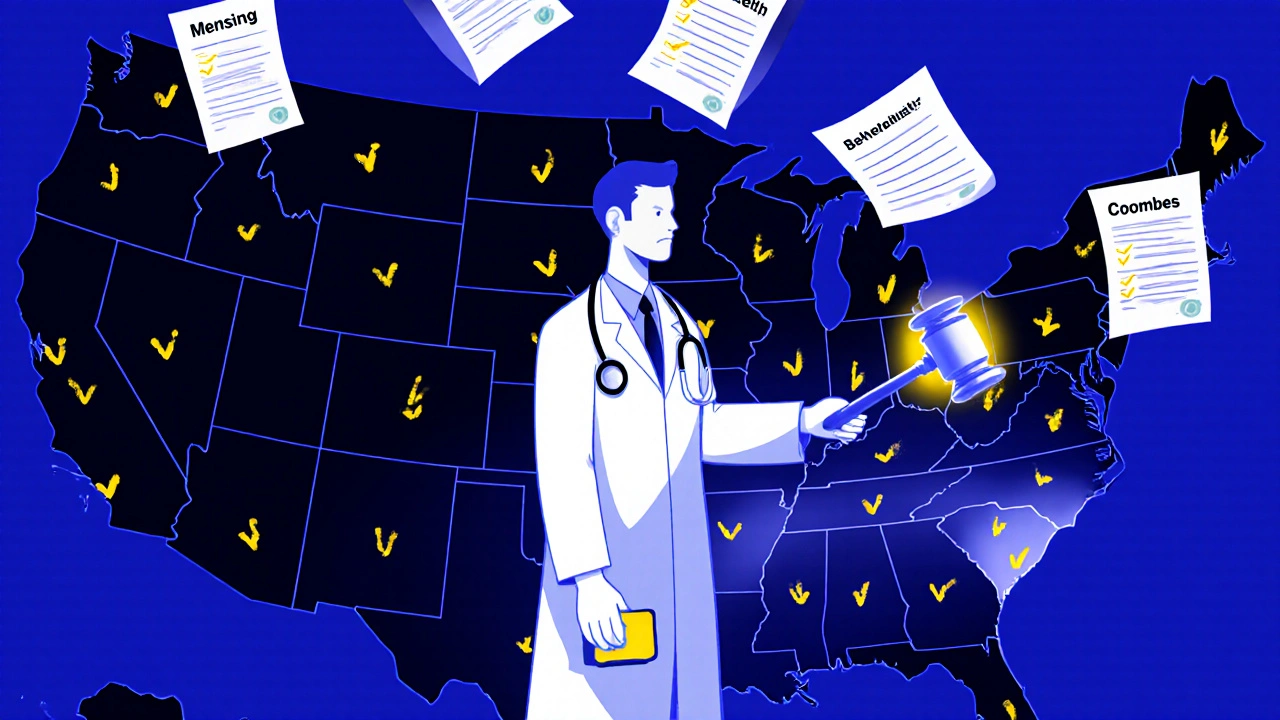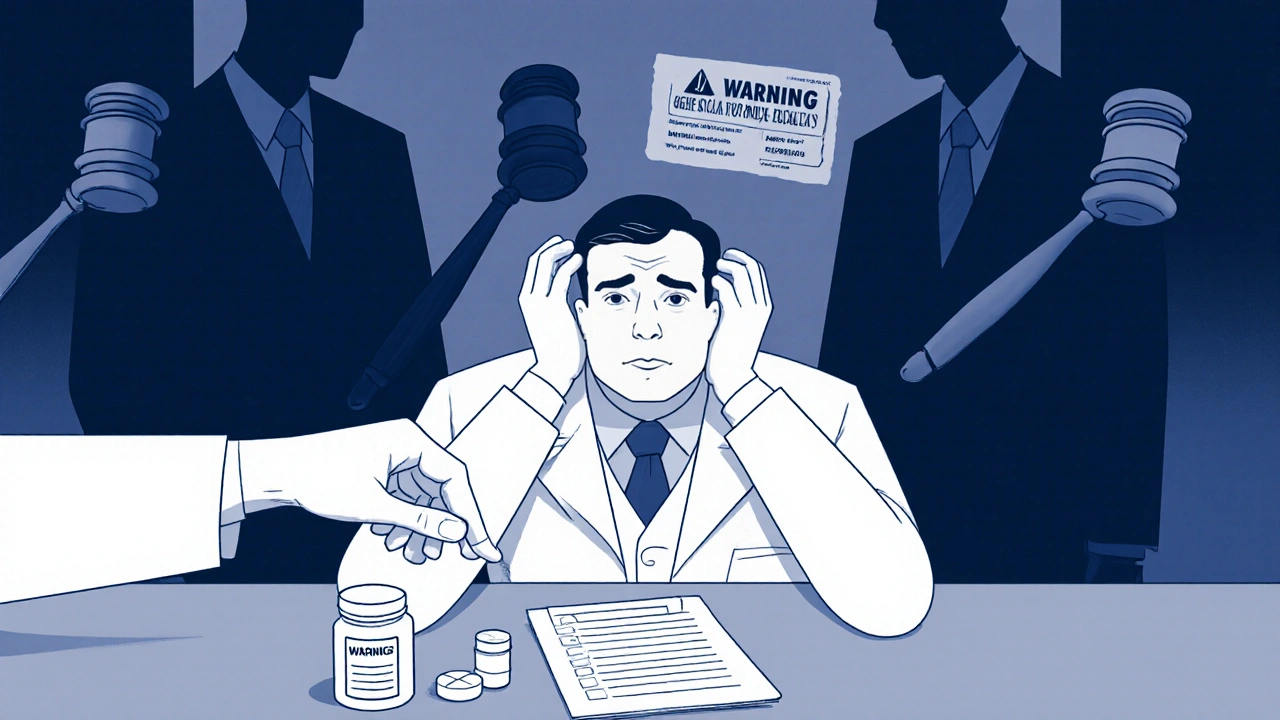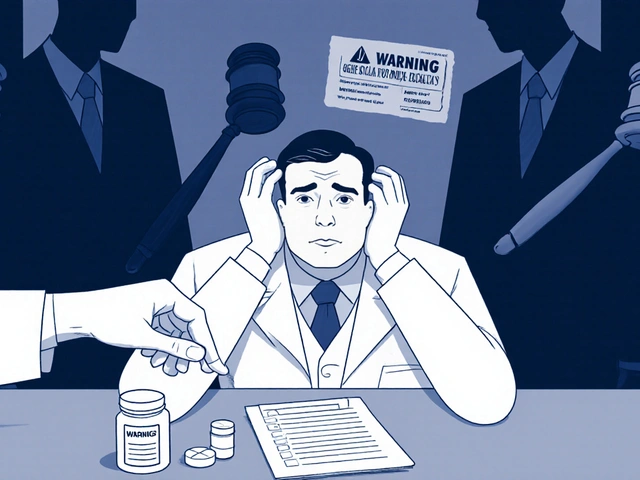When you prescribe a generic drug, you might think you’re doing the right thing-saving your patient money, following guidelines, keeping costs down. But in today’s legal climate, that simple act could put your license, your practice, and your finances at risk. The truth is, physician liability for generic drug injuries has grown dramatically since 2011, and most doctors don’t realize how exposed they are.
Why Generic Drugs Changed Everything
In 2011, the U.S. Supreme Court ruled in PLIVA, Inc. v. Mensing that generic drug manufacturers can’t be sued for failing to update warning labels. Why? Because federal law forces them to copy the brand-name drug’s label exactly. They can’t change it, even if new safety data emerges. Then in 2013, the Court doubled down in Mutual Pharmaceutical Co. v. Bartlett, shutting down another path for patients to sue manufacturers over design defects. The result? A legal black hole. Patients harmed by generic drugs-like Karen Bartlett, who lost 65% of her skin after taking generic sulindac-have almost no one to sue. The manufacturer is protected. The pharmacist who dispensed it? Usually not liable. That leaves one target: the doctor who wrote the prescription.What Makes a Doctor Liable?
To win a malpractice case against you, a patient doesn’t need to prove you were careless. They just need to show three things:- You had a duty to the patient (you were their doctor)
- You breached the standard of care (you didn’t act like a reasonable physician would)
- That breach directly caused their injury
State Laws Are a Patchwork
Forty-nine states let pharmacists swap a brand-name drug for a generic unless you write “dispense as written” or “do not substitute.” But the rules vary wildly. In 32 states, the pharmacist must notify you within 72 hours if they switch the drug. In 17 states? No notification required. That means you could be prescribing one thing, and the patient walks out with something else-without you ever knowing. Some states have tried to fix this. Illinois courts have ruled that generic manufacturers must update labels if a drug is dangerously flawed. But in most states, the federal preemption rule holds firm. That means your liability exposure depends entirely on where you practice. A doctor in Alabama faces a different legal landscape than one in California or New York.
What You’re Doing Now Might Be Putting You at Risk
A 2022 survey of 1,200 physicians found that 68% feel more anxious about prescribing generics than they did five years ago. Forty-two percent admit they sometimes prescribe the more expensive brand-name drug-not because it’s better, but because they’re scared of being sued. One doctor in Massachusetts told a colleague: “I now write out detailed warnings for every prescription. It adds 15 to 20 minutes to every visit.” That’s not efficiency. That’s fear driving practice. And it’s not just anecdotal. The American College of Physicians documented 47 malpractice claims tied to generic drugs between 2016 and 2021. Twelve of those ended in settlements averaging over $327,500. Your professional liability insurer isn’t blind to this trend. They’re now charging up to 7.3% more in premiums for doctors who don’t document specific counseling about generic substitution.How to Protect Yourself: The 4-Step Protocol
You don’t have to stop prescribing generics. But you do need to change how you do it. Here’s what works:- Use “dispense as written” for high-risk drugs. This includes warfarin, levothyroxine, phenytoin, and other medications with narrow therapeutic windows. Even small changes in dosage can cause serious harm. In 32 states, this notation legally blocks substitution.
- Document specific counseling. Don’t just write “medication discussed.” Say exactly what you said. Example: “I explained that [medication] can cause dizziness and blurred vision. Advised patient not to drive or operate machinery until they know how it affects them. Patient acknowledged understanding.”
- Use your EHR’s built-in tools. Epic Systems and other major platforms added mandatory fields in 2021 for documenting generic substitution counseling. Use them. They’re there for a reason.
- Know your state’s substitution rules. Check your state pharmacy board’s website annually. Rules change. If your state doesn’t require pharmacist notification, assume substitutions happen silently.

What’s Coming Next
The legal landscape isn’t frozen. In March 2023, the 9th Circuit Court created a narrow exception: if a brand-name manufacturer updates its warning label and the generic maker ignores it, the generic company can be sued. It’s a small crack in the wall-but it could grow. The American Medical Association is pushing for state laws requiring pharmacists to notify doctors within 24 hours of substituting high-risk generics. Bills are active in 18 states as of 2023. If passed, this could reduce your liability by giving you real-time visibility into what your patients are actually taking. Meanwhile, lawsuits targeting physicians are rising. The American Bar Association reported a 37% increase in physician liability cases involving generic drugs between 2014 and 2019. Harvard Medical School’s Aaron Kesselheim predicts a 45% rise by 2027 if nothing changes.It’s Not About Fear. It’s About Control.
You didn’t go to medical school to become a legal risk manager. But the system has changed. The manufacturers are shielded. The regulators are slow. The patients are angry. And you’re the only one left standing between them and a lawsuit. The good news? You have control. You can choose which drugs to flag. You can document your conversations. You can insist on clarity. You don’t have to prescribe brand-name drugs out of fear. You just have to do your job with intention-and paper trails to prove it. The next time you write a prescription for a generic, ask yourself: Did I say exactly what needed to be said? Did I write it down? If the answer is yes, you’re not just protecting your patient-you’re protecting yourself.Can I be sued if a pharmacist substitutes a generic without my permission?
Yes, potentially. In 17 states, pharmacists aren’t required to notify you if they substitute a generic. If the substituted drug causes harm and you didn’t document specific warnings about its risks, you could still be held liable. The law holds you responsible for the medication’s effects, regardless of who dispensed it.
Does prescribing a brand-name drug protect me from liability?
No. You’re still liable if you fail to warn the patient about known side effects. But if the patient is injured by a brand-name drug, the manufacturer can also be sued. With generics, the manufacturer is legally immune under federal preemption, so the burden falls entirely on you.
Should I avoid prescribing generics altogether?
No. Generics are safe, effective, and cost-saving for most patients. The goal isn’t to stop prescribing them-it’s to prescribe them wisely. Use “dispense as written” for high-risk drugs, document counseling clearly, and know your state’s substitution laws. That’s how you reduce risk without sacrificing care.
What if my patient says they’re fine with a generic substitution?
Patient consent doesn’t eliminate your liability. Even if they say, “I don’t care which one I get,” you still have a duty to warn them about potential risks of the specific medication. Verbal agreement isn’t enough. You need to document the discussion in writing, including the side effects you discussed and any advice you gave.
Are electronic health records helping or hurting my legal position?
They’re helping-if used correctly. Modern EHR systems now require you to document generic counseling, which creates a clear audit trail. But if you just click through without typing real notes, you’re creating a false record. The system won’t protect you. Your detailed, accurate documentation will.



David Barry
November 14, 2025 at 04:08Let’s be real-this isn’t about liability, it’s about systemic abandonment. The FDA and Congress let pharma off the hook, then turned around and made doctors the scapegoats. You’re not a pharmacist, you’re not a label designer, yet you’re the one getting sued when a generic’s side effects aren’t documented in a 1998 FDA template that hasn’t changed since dial-up. The system is broken. And no amount of EHR checkboxes fixes that.
Alyssa Lopez
November 14, 2025 at 05:07OMG YES. I’ve been saying this for YEARS. Generic = legal landmine. I switched to brand only for anything with a narrow window. My malpractice premium went up 5% but at least I’m not getting sued by some guy who got dizzy and crashed his bike. Also, why do we even let pharmacists swap stuff? They’re not doctors. #MedicineNotRetail
Alex Ramos
November 15, 2025 at 19:11Been using the Epic mandatory fields since 2022. Game changer. I just copy-paste the standard warning template for high-risk meds now. Saves time, covers my butt. Also, I always add a 👍 after “patient acknowledged understanding.” Small thing, but it feels like a digital handshake. 🤝
Benjamin Stöffler
November 16, 2025 at 10:27There’s a deeper philosophical issue here: if a physician is held liable for a drug’s label, then by extension, every act of medical judgment becomes an act of regulatory compliance-and thus, medicine is no longer a science, but a bureaucratic performance. We are not custodians of health; we are clerks of litigation. The Supreme Court didn’t create this vacuum-it merely exposed the rot: medicine has been outsourced to lawyers, and physicians are now the last unpaid interns in the system.
Moreover, the notion that “documentation” protects you is a myth. A court doesn’t care about your neatly formatted EHR entries if the patient’s neurologist testified that the warning was clinically irrelevant. You’re not protected by paper-you’re protected by precedent, and precedent is a fickle god.
And let’s not forget: patients don’t read labels. They don’t understand “dizziness.” They understand “I got sick.” So your warning, no matter how eloquent, is functionally noise. The real solution? Repeal federal preemption. Or better yet-let manufacturers be liable again. Then we can go back to being doctors, not paralegals with stethoscopes.
And yes-I’ve started writing “dispense as written” on everything. Even for ibuprofen. Because why not? The system rewards paranoia. And I’m not brave enough to be the martyr who gets sued for “overprescribing.”
Also, the 7.3% premium hike? That’s not a cost-it’s a tax on ignorance. The insurance companies know this. They’re not trying to help you. They’re trying to make you pay for their own regulatory failures.
And for the love of Hippocrates, stop saying “patient acknowledged understanding.” That’s not a legal defense. That’s a fairy tale you tell yourself so you can sleep at night.
One last thing: if you think this is just about generics, you’re delusional. The same logic applies to off-label use, AI diagnostics, and telehealth misdiagnoses. The legal net is tightening. And we’re all just waiting for the other shoe to drop.
Mark Rutkowski
November 16, 2025 at 13:28I get the fear. I really do. But let’s not let fear turn us into ghosts of our former selves. Medicine used to be about trust-not transactional risk mitigation. We can protect ourselves without becoming paranoid. I still prescribe generics. I still talk to my patients. I still write notes-not because I’m scared, but because I care. And you know what? My patients notice. They remember the doctor who took the time to explain, not the one who just clicked through checkboxes.
Yes, the system is broken. But we’re not powerless. We’re still the ones who hold the stethoscope. We’re still the ones who sit across from someone scared, confused, or in pain. That matters. More than any EHR template. More than any lawsuit. The art of medicine isn’t dead-it’s just being drowned out by noise.
So yes-use the protocols. Document wisely. Know your state laws. But don’t forget why you became a doctor in the first place. Not to avoid liability. To heal. Even in a broken system, that’s still worth fighting for.
Ryan Everhart
November 18, 2025 at 04:05So… you’re telling me I have to write a novel every time I scribble a prescription? Cool. Got it. And I’m supposed to believe that if I say ‘do not drive’ in my EHR, some judge will magically decide I’m not guilty? Meanwhile, my patient is in court saying they never heard me say anything. Guess what? That’s not a documentation problem. That’s a culture problem. And nobody’s fixing that.
Eve Miller
November 18, 2025 at 14:26Anyone who says “patient acknowledged understanding” is delusional. That phrase is legally meaningless. It’s not evidence. It’s theater. You must document the specific side effects, the exact advice given, the time of the conversation, and the patient’s verbal response-not just a checkbox. If you’re not doing that, you’re not protecting yourself. You’re just gambling with your license. And that’s not just irresponsible-it’s unethical.
edgar popa
November 20, 2025 at 00:20Just start writing ‘dispense as written’ on everything. Seriously. It takes 2 seconds. Done. No more stress. No more lawsuits. You’re welcome.
Chrisna Bronkhorst
November 21, 2025 at 03:20Let’s cut the crap. The real problem isn’t the doctors. It’s the pharma lobbyists who wrote the 2011 ruling. The FDA is a puppet. The courts are complicit. And now we’re all paying for it with our malpractice premiums and sleepless nights. This isn’t about documentation. It’s about power. And the power belongs to the corporations. We’re just the front-line cannon fodder.
Amie Wilde
November 22, 2025 at 04:07I just tell patients: ‘This is generic. It’s the same, but if you feel weird, call me.’ And I write that down. That’s it. I’m not writing a novel. If they crash because they didn’t listen? That’s on them. I did my part.
Gary Hattis
November 24, 2025 at 01:14Here’s the thing-this isn’t just an American problem. I practiced in South Africa and we had the same issue. Generic substitution? No warning requirements. Doctors got sued anyway. The global trend is clear: when manufacturers are shielded, the burden shifts to the prescriber. It’s not fair. But it’s the reality. Adapt or get crushed. The solution? Systemic reform. But until then? Document like your license depends on it. Because it does.